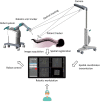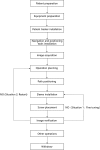Guideline for Thoracolumbar Pedicle Screw Placement Assisted by Orthopaedic Surgical Robot
- PMID: 31025807
- PMCID: PMC6594520
- DOI: 10.1111/os.12453
Guideline for Thoracolumbar Pedicle Screw Placement Assisted by Orthopaedic Surgical Robot
Abstract
The pedicle screw placement procedure is the most commonly used technique for spinal fixation and can provide reliable three-column stabilization. Accurate screw placement is necessary in clinical practice. To avoid screw malposition, which may decrease the stiffness of the screw-rod construct or increase the likelihood of neural and vascular injuries, the surgeons must fully understand the regional anatomy. Deformities, such as scoliosis, kyphosis or congenital anomalies, may complicate the application of the pedicle screw placement technique and increase the chance of screw encroachments. Incidences of pedicle screw malposition vary in different districts and hospitals and with surgeons and techniques. Today, the minimally invasive spinal surgery is well developed. However, the narrow corridors and limited views for surgeons increase the difficulty of pedicle screw placement and the possibility of screw encroachment. Evidenced by previous studies, robotic surgery can provide accurate screw placement, especially in settings of spinal deformities, anatomical anomalies, and minimally invasive procedures. Based on the consensus of consultant specialists, the literature review and our local experiences, this guideline introduces the robotic system and describes the workflow of robot-assisted procedures and the precautions to take during procedures. This guideline aims to outline a standardized method for robotic surgery for thoracolumbar pedicle screw placement.
Keywords: Accuracy; Pedicle screw; Robot-assisted surgery; Thoracolumbar spine.
© 2019 The Authors. Orthopaedic Surgery published by Chinese Orthopaedic Association and John Wiley & Sons Australia, Ltd.
Figures





References
-
- Boucher HH. A method of spinal fusion. J Bone Joint Surg Br, 1959, 41: 248–259. - PubMed
-
- Barnes AH, Eguizabal JA, Acosta FL Jr, Lotz JC, Buckley JM, Ames CP. Biomechanical pullout strength and stability of the cervical artificial pedicle screw. Spine (Phila Pa 1976), 2009, 34: E16–E20. - PubMed
-
- Verma K, Boniello A, Rihn J. Emerging techniques for posterior fixation of the lumbar spine. J Am Acad Orthop Surg, 2016, 24: 357–364. - PubMed
-
- Katonis P, Christoforakis J, Kontakis G, et al Complications and problems related to pedicle screw fixation of the spine. Clin Orthop Relat Res, 2003, 414: 86–94. - PubMed
-
- Jutte PC, Castelein RM. Complications of pedicle screws in lumbar and lumbosacral fusions in 105 consecutive primary operations. Eur Spine J, 2002, 11: 594–598. - PubMed
Publication types
MeSH terms
Grants and funding
LinkOut - more resources
Full Text Sources
Other Literature Sources

